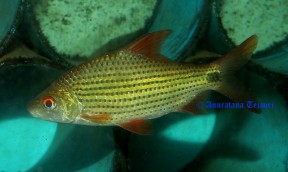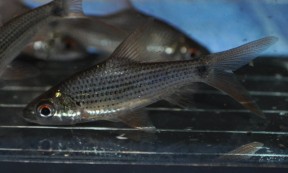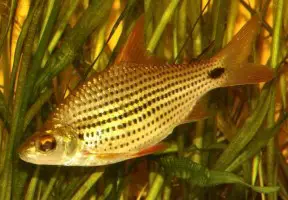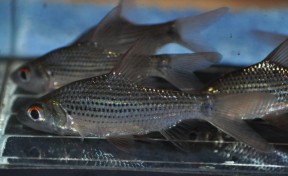Cyclocheilichthys apogon
Beardless Barb
SynonymsTop ↑
Barbus apogon Valenciennes, in Cuvier & Valenciennes, 1842; Systomus apogonoïdes Bleeker, 1855k; Cyclocheilichthys rubripinnis Fowler, 1934; Cyclocheilichthys rubripinnis var. microcephala Pellegrin & Chevey, 1940; Rohteichthys macrolepis Holly, 1927
Etymology
Cyclocheilichthys: from the Ancient Greek κύκλος (kýklos), meaning ‘circle’, χείλος (cheílos), meaning ‘lip’, and ἰχθύς (ikhthús), meaning ‘fish’, possibly in reference to the continuous lips in this genus.
apogon: from the Ancient Greek ἀ- (a-), meaning ‘without’, and πώγων (pōgōn), meaning ‘beard’, in reference to the absence of barbels in this species.
Classification
Order: Cypriniformes Family: Cyprinidae
Distribution
Type locality is given simply as ‘Java, Indonesia’, but this species is currently understood to have an enormous natural range extending eastwards from Myanmar via Thailand, Laos, Cambodia as far as Vietnam and to the south through Peninsular Malaysia and into the Greater Sunda Islands of Borneo and Sumatra.
It thus occurs throughout the Mekong, Mae Klong and Chao Phraya drainages as well as a host of smaller river basins, lakes and reservoirs. It is used as a food fish in some countries and may vary a little in colouration and patterning depending on collection locality. The precise extent to which it’s been artificially-introduced across this range is unclear.
Habitat
Primarily a riverine fish showing a preference for slower-moving or still zones including swamps, canals, and ditches, although it’s also been recorded in faster-flowing, rocky stretches and peat swamp forests. Submerged tree roots, branches and plants are favoured habitats as it grazes the rich biofilm that forms on such surfaces.
It’s now also found inhabiting many artificial water bodies as a result of human interference; some populations have been deliberately introduced into new waters for aquaculture or angling purposes while others have had their habitat altered dramatically due to damming or agriculture. During the wet season it is known to move into inundated floodplains and forested.
An example of a typical natural biotope is the Sungai Batang, a tributary of the Beris system in the state of Kedah, northern Peninsular Malaysia. Here the water is fairly shallow (<2m deep), moderately-flowing and the substrate composed of sand and pebbles with a covering of submerged wood and other debris. No aquatic plants are present although the river flows through a section of low-lying primary forest which presumably adds some shelter.
C. apogon is found living alongside various species including Barbodes binotatus, B. lateristriga, Garra cambodgiensis, Devario regina, Homaloptera orthogoniata, Homalopteroides smithi, Laubuca laubuca, Crossocheilus oblongus, Glyptothorax major, Rasbora sumatrana and Mystacoleucus obtusirostris.
Maximum Standard Length
150 – 180 mm.
Aquarium SizeTop ↑
An aquarium with base measurements of at least 180 ∗ 45 cm will be required for long-term care.
Maintenance
Prefers a dimly-lit environment and a soft sand substrate is recommended. The addition of some good-sized pieces of driftwood will provide shady patches that will be appreciated. If you can’t find driftwood of the desired shape common beech or oak is safe to use if thoroughly dried and stripped of bark.
While many aquatic plants will fail to thrive in such conditions species such as Microsorum, Taxiphyllum or perhaps some potted Cryptocorynes spp. should survive. The broad-leaved species are ideal as this fish likes to graze them for food. A few patches of floating vegetation would also help to further diffuse the light entering the tank and provide a more natural feel.
Water Conditions
Temperature: 20 – 27 °C
pH: Happy within the range 5.5 – 8.0 but a value close to neutral is usually recommended.
Hardness: 18 – 357 ppm
Diet
In nature this species is primarily a micropredator grazing aufwuchs for small items including insects, crustaceans and the fry of other fish. For it to develop the best condition in the aquarium offer regular meals of small live and frozen foods such as bloodworm, Daphnia and Artemia along with good quality dried flakes and granules.
Behaviour and CompatibilityTop ↑
An ideal resident of the larger, well-furnished community set-up though large adults may intimidate slow-moving or particularly timid companions. There are plenty of suitable tankmates, however, including many cyprinids, loaches, cichlids, catfish and characins. A community based around one of its native countries or river basins would also make a worthwhile project with some interesting alternatives (see ‘Habitat’).
It is a gregarious species by nature and ideally should be kept in a group of at least six. The fish display better colouration in the presence of conspecifics, are less nervous and the display on the whole will appear more natural-looking.
Sexual Dimorphism
Sexually mature females are likely to be thicker-bodied than males.
Reproduction
Not thought to have been bred in aquaria to date. In nature it spawns in flooded zones towards the end of the wet season.
NotesTop ↑
In the aquarium trade this species may also be seen on sale as ‘skinhead barb’. As with others in the genus little has been written regarding its captive care but it makes a peaceful and unusual addition to larger aquaria. The best way of obtaining it may be to keep an eye on shipments of wild fishes from Indochina and the Greater Sunda Islands as it’s rarely imported in large numbers and most often arrives as bycatch.
It can be distinguished from congeners by lacking barbels, possessing a black blotch at the base of the caudal-fin, and rows of dark spots along the lateral scale rows.
Members of Cyclocheilichthys are characterised by possessing a serrated dorsal fin spine, 9 branched pelvic fin rays, a conical snout, small, subterminal mouth and parallel rows of sensory folds on the snout and cheeks. The latter feature is lacking in most other cyprinids but present in a few genera including Eirmotus, Oreichthys, Neobarynotus, plus a handful of other species.
There have been some nomenclatural issues in recent years, ostensibly because Cyclocheilichthys and the now synonymous Anematichthys were used simultaneously by Bleeker (1859) in reference to the same fish, C. apogon. The issue was addressed by Kottelat (1999) but later misinterpreted by Pasco-Viel, Veran and Variot, 2012, who concluded that Cyclocheilichthys represents a paraphyletic grouping and split the genus into two groups: Cyclocheilichthys (comprising C. enoplos) and Anematichthys (comprising C. apogon, C. armatus and C. repasson).
This was corrected by Kottelat (2013), and Cyclocheilichthys currently comprises seven species with the revalidated genus Cyclocheilos including the former members C. enoplos and C. furcatus. C. heteronema differs considerably from other Cyclocheilichthys species and may eventually be separated with the generic name Oxybarbus available for it.
Given the extremely wide range exhibited by C. apogon, and taking into account patterns observed in other Southeast Asian fishes, it seems logical that this species may also turn out to represent a group of closely-related taxa.
References
- Valenciennes, in Cuvier & Valenciennes, 1842 - Histoire naturelle des poissons v. 16: i-xx + 1-472
Histoire naturelle des poissons. Tome seizième. Livre dix-huitième. Les Cyprinoïdes. - Cervancia, M. and M. Kottelat, 2007 - Raffles Bulletin of Zoology 55(1): 141-145
Cyclocheilichthys schoppeae, a new species of freshwater fish (Teleostei: Cyprinidae) from northern Palawan, Philippines. - Freyhof, J., D. V. Serov, and T. N. Nguyen, 2000 - Bonner Zoologische Beiträge 49(1-4): 93-99
A preliminary checklist of the freshwater fishes of the River Dong Nai, South Vietnam. - Kottelat, M., 1999 - Raffles Bulletin of Zoology 47(2): 591-600
Nomenclature of the genera Barbodes, Cyclocheilichthys, Rasbora and Chonerhinos (Teleostei: Cyprinidae and Tetraodontidae), with comments on the definition of the first reviser. - Kottelat, M., 2001 - WHT Publications, Colombo: 1-198
Fishes of Laos. - Kottelat, M., 2013a - Zootaxa 3640(4): 479-482
The valid generic names for the fish species usually placed in Cyclocheilichthys (Pisces: Cyprinidae). - Kottelat, M., 2013b - Raffles Bulletin of Zoology Supplement 27: 1-663
The fishes of the inland waters of southeast Asia: a catalogue and core bibiography of the fishes known to occur in freshwaters, mangroves and estuaries. - Kottelat, M. and E. Widjanarti, 2005 - Raffles Bulletin of Zoology Supplement 13: 139-173
The fishes of Danau Sentarum National Park and the Kapuas Lakes area, Kalimantan Barat, Indonesia. - Ng, H. H. and H.-H. Tan, 1999 - Zoological Studies 38(3): 350-366
The fishes of the Endau drainage, Peninsular Malaysia with descriptions of two new species of catfishes (Teleostei: Akysidae, Bagridae). - Pasco-Viel, E., M. Veran and L. Variot , 2012 - Zootaxa 3586: 41-54
Bleeker was right: Revision of the genus Cyclocheilichthys (Bleeker 1859) and resurrection of the genus Anematichthys (Bleeker 1859), based on morphological and molecular data of Southeast Asian Cyprininae (Teleostei, Cypriniformes). - Pasco-Viel, E., M. Veran and L. Variot , 2013 - Zootaxa 3640(3): 483-484
Comments on 'The valid generic names for the fish species usually placed in Cyclocheilichthys' (KOTTELAT 2013) and a correction of Pasco-viel et al. (2012). - Rainboth, W. J., 1996 - FAO, Rome: 1-265
Fishes of the Cambodian Mekong. FAO Species Identification Field Guide for Fishery Purposes. - Tan, H. H. and M. Kottelat, 2009 - Ichthyological Exploration of Freshwaters 20(1): 13-69
The fishes of the Batang Hari drainage, Sumatra, with description of six new species.






